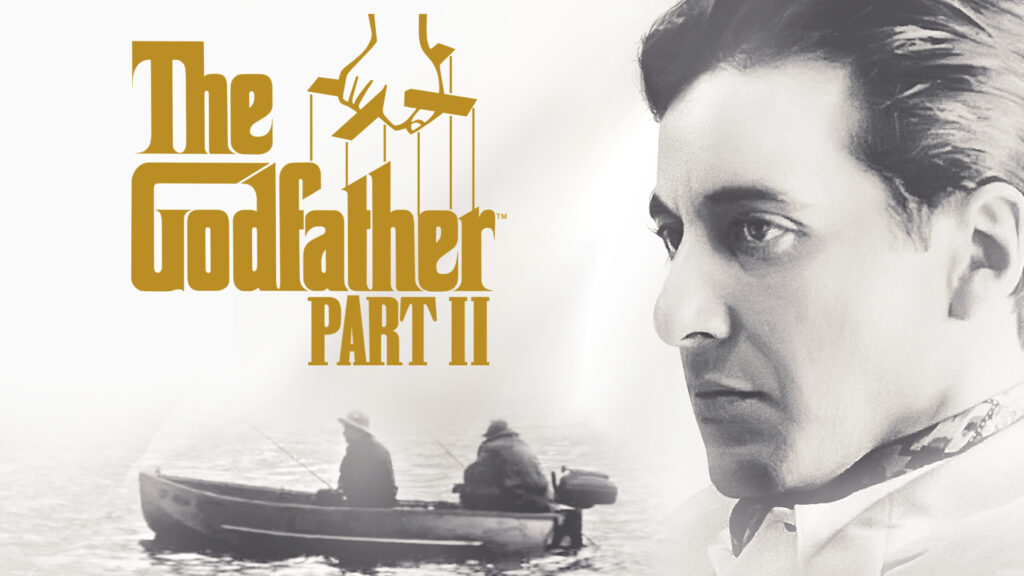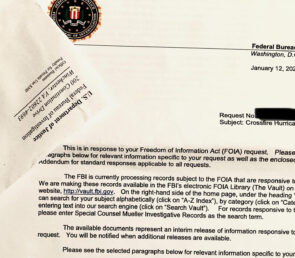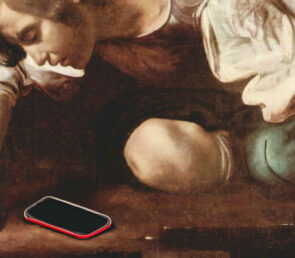
Media Machinations: Orchestrating Division in the Digital Age (Godfather II)
Date : February 8, 2024 By
Almost half a century ago, The Godfather Part II, directed by Francis Ford Coppola (1974), first revealed the alarming scope of systemic corruption, foreshadowing its amplification through mass-media-induced hypnosis. The opening flows from Vito Corleone’s tragic escape from Sicily after his family’s murder to the procession of his grandson’s first communion in America. Both a prequel and sequel to necessary context, the story depicts Vito’s escape to America and rise to power after he murders violent extortionist Don Fanucci for exploiting fellow Italian immigrants. Right before Fanucci’s death, Coppola transparently reveals his message of media influence in a puppet show as Fanucci ironically scoffs that the portrayal is far too violent. After his murder, Vito fills the power vacuum by becoming a custodian of reciprocal altruisms.
The Godfather Part II mirrors father and son’s lives as first- and second-generation immigrants, following Vito’s son Michael as the new head of the Corleone family upon returning to America. His enterprises span from hostile takeovers of Las Vegas venues to suspect Jewish and Cuban partnerships he unwittingly sabotaged. Michael’s congressional testimony follows the aftermath of his brother Fredo’s betrayal and the hit on Michael’s home, which ends in Fredo’s death. Vito returns to Sicily decades later to kill Don Ciccio for murdering his family, and the film closes with Vito’s death and the demise of Michael’s marriage. The Godfather Part II unveils the connections between media and corruption, the susceptibility of alliances to external pressures, and the limits of trust, reconciliation, and the enduring cycle of vengeance.
The organization of correlational stimuli to understand and effectively respond to the environment is integral to being human. Samovar et al. (2017) define the application of this classification process with social behaviors as stereotyping and reveal that although natural and necessary, “problems arise when you tend to overgeneralize” (p.389) — for example, smuggled out of Sicily alone on a packed ship to Ellis Island, immigration processed silent Vito’s surname according to his town of origin, consigning his future reign as an Italian mafioso. Bergesen (1979) reports the shift to stereotype all Italians as criminals, referring to them as white ethnics; however, during a solid chunk of American history, Italian immigrants were not considered white (Guglielmo, 2012). Indeed, the film portrays powerful Italian families as criminals. Samovar et al. (2017) highlight how inflexible adherence to these stereotypes impedes successful intercultural communication by presenting a mere caricature of the individual.
Samovar et al. (2017) define prejudice as an attitude toward people from another group based on groundless comparisons made between that group and one’s ingroup, borrowing elements of psychological projection. For example, Nevada senator Pat Geary exemplifies prejudice as he extorts Michael’s interest in obtaining a gaming license for the Tropigala, telling him that he intends to squeeze him, saying, “I don’t like to see you come out to this clean country in your oily hair dressed up in those silk suits trying to pass yourselves off as decent Americans” (Coppola, 1974, 17:55). Michael attempts to reason with Geary, who exemplifies the dominant culture, submitting that they may both present artifice. Unfortunately, prejudice leads to an “unproductive exchange rather than a reasoned discussion” (Samovar et al., 2017, p. 391). Geary then finds himself with a bound, dead prostitute and amnesia, relying on the Corleones to cover.
Racism — the belief that inherent genetic superiority/inferiority determines success over opportunity (Samovar et al., 2017) — is evident from an evolving definition of race as Italian immigrants advanced in the ranks of whites. The Corleones fought powerful, escalating criminal
syndicates that selected other groups to exploit with narcotics, characterizing them as inhuman. Accordingly, one of the root causes of racism is economics, denying individuals their identity and destroying culture (Samovar et al., 2017), which presents “a major hindrance to successful intercultural communication” (Samovar et al., 2017, p. 396). An exchange between Michael and his family friend Frank Pentangeli illustrates the effects of targeted cultural destruction for profit. Pentangeli challenges Michael’s forming partnership with Jewish investor and main antagonist Hyman Roth by resenting Roth’s backing of the encroaching Rosato gangsters, where he describes them as animals who “recruit niggers and spicks; they do violence in their own Grandmother’s neighborhoods. And everything is dope and whores” (Coppola, 1974, 31:02). Michael mistakenly dismisses his guest’s ramblings in favor of his Cuban investment interests with Roth before Michael is targeted for execution that night.
Samovar et al. (2017) define ethnocentrism as the belief in the superiority of one’s culture over others. Coppola contrasts Vito’s and Michael’s cultural orientation in America and Italy and portrays how the Italian sanctification of courtship and marriage gave way to promiscuity and frivolous debauchery in the West. Vito maintains these values, asserting that he only has eyes for his wife during a play where his friend ogles an actress. Vito’s son aligns similarly; yet, despite Michael’s refusal to partake personally, his business ventures profited from them. This repeated characterization unveils an ethnocentric view of virtue besmirched by the corruption of Western enterprise, cementing the film’s plot when Roth covertly discloses to Michael his motivation for targeting him — the murder of his friend Moe Greene for his shares in the casino. Epitomizing the “downward spiral in relations” (Samovar et al., 2017, p. 385), Roth discreetly references the day Michael kicks the girls out of the casino party. Michael strongarms Moe, whose death sets the events in The Godfather Part II in motion. Finally, in the most telling metaphor, Michael has Roth killed at a highly-guarded airport using his caporegime posing as a reporter.
The Godfather Part II develops a complex theme of the incredibly relevant struggle to create a just and free society in an unjust world littered with corruption at every level of business and government. The film, which uses puppeteer iconography in the film’s logo, shows how media representation shapes the communication between the host and minority cultures as an inseparable component. Coppola’s effort for message legitimacy is similar to the heads of the Corleone family. Navigating through the same environment of media he depicts as corrupt throughout, Coppola implicitly conveys how rising within this criminal organization was the pinnacle of assimilation and, most notably, associates the role of the media in the process of maintaining established power by trafficking in the virtues and vices of those on all rungs of the status ladder — strategically using the construct of otherness to divide.
The relationship between media and influential organizations is far from fiction, with United States government agencies openly boasting about Hollywood and media partnerships (United States Department of Defense [@DeptofDefense], 2018 & Central Intelligence Agency [@CIA], 2018), while their pull in sociopolitical discourse and historical revisionism is intractable (Alford, 2016). Moreover, unclassified records reveal the common practice of engaging online influencers on unchecked commercial platforms (U.S. Department of State, 2014). Arguably the greatest weapon, foreign adversaries also wield propaganda (Brady, 2015), feeding narcissistic behavioral patterns in America (Meng & Leung, 2021), which lie at the core of othering. Coppola illuminates that the inability to recognize media at the helm of the information war precludes the capacity to sever these strings of orchestrated division.
References
Alford, M. (2016). The political impact of the Department of Defense on Hollywood cinema. Quarterly Review of Film and Video, 33(4), 332-347.
Bergesen, A. (1979). Godfather II: Some thoughts on our changing conception of immigrants and organized crime. Contemporary Crises, 3, 291.
Brady, A. M. (2015). Authoritarianism goes global (II): China’s foreign propaganda machine. Journal of Democracy, 26(4), 51-59.
Central Intelligence Agency [@CIA]. (2018, August 29). CIA officers work as. . . Twitter. Retrieved February 12, 2023, from https://twitter.com/CIA/status/1034866941587087360
Coppola, F. (Director). (1974). The Godfather Part II [Film]. Paramount Pictures.
Guglielmo, T. A. (2012). “No Color Barrier”: Italians, Race, and Power in the United States. In Are Italians White? (pp. 29-43). Routledge.
Meng, K. S., & Leung, L. (2021). Factors influencing TikTok engagement behaviors in China: An examination of gratifications sought, narcissism, and the Big Five personality traits. Telecommunications Policy, 45(7), 102172.
Samovar, L. A., Porter, R. E., McDaniel, E. R., & Roy, C. S. (2017). Communication between cultures. Boston, MA: Cengage Learning.
United States Department of Defense [@DeptofDefense]. (2018, March 4). Did you know the #DoD works with #Hollywood? [Online forum post]. Twitter. Retrieved February 12, 2023, from https://twitter.com/DeptofDefense/status/970461390283587585
U.S. Department of State. (2014, February 6). Virtual reading room documents. U.S. Department of State Freedom of Information Act. https://foia.state.gov/Search/Results.aspx?searchText=media+assets

A Summa Cum Laude graduate (4.0 GPA) of Purdue Global University with a baccalaureate in the Science of Communications, my multidisciplinary experience ranges from journalism to marketing and web development. I presented my work on hashed usernames for privacy and transparency in aggregate data at a special session on data provenance at the NSA’s Symposium on the Science of Security.
https://buymeacoffee.com/crystalgonzalez
https://cash.app/$crystalgonzalez0




